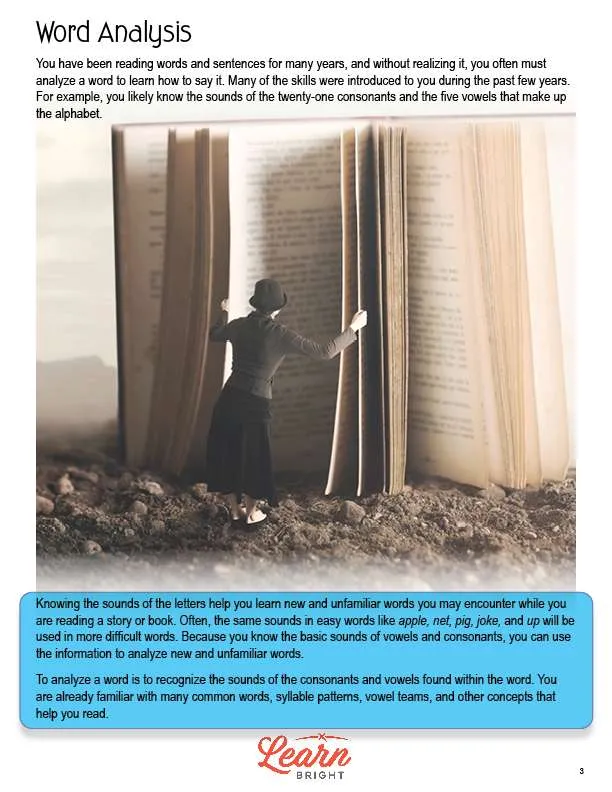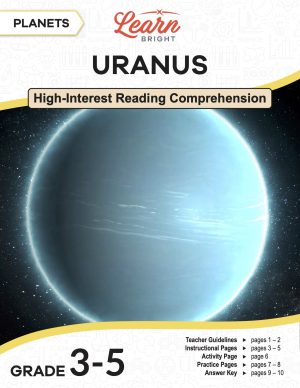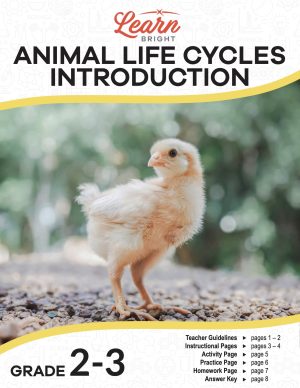Description
What our Word Analysis and Decoding Review lesson plan includes
Lesson Objectives and Overview: Word Analysis and Decoding Review teaches students how to decode words using various forms of analysis. At the end of the lesson, students will be able to know and apply grade-level phonics and word analysis skills in decoding words. This lesson is for students in 3rd grade.
Classroom Procedure
Every lesson plan provides you with a classroom procedure page that outlines a step-by-step guide to follow. You do not have to follow the guide exactly. The guide helps you organize the lesson and details when to hand out worksheets. It also lists information in the yellow box that you might find useful. You will find the lesson objectives, state standards, and number of class sessions the lesson should take to complete in this area. In addition, it describes the supplies you will need as well as what and how you need to prepare beforehand. The supplies you will need for this lesson are dictionaries and the handouts. To prepare for this lesson ahead of time, you can pair students for the activity, gather the supplies, and copy the handouts.
Options for Lesson
Included with this lesson is an “Options for Lesson” section that lists a number of suggestions for activities to add to the lesson or substitutions for the ones already in the lesson. If you want to add to the lesson activity, you can incorporate other current reading content or find additional passages to use. For an additional activity, students can create their own word puzzles like the one included on the practice page. You can use adlibs to help students with word decoding and analysis; students can also create their own adlibs to share with other students, who can fill in the blanks. Finally, you can create a list of word analysis and decoding strategies for students to use and refer to throughout the school year.
Teacher Notes
The teacher notes page includes a paragraph with additional guidelines and things to think about as you begin to plan your lesson. This page also includes lines that you can use to add your own notes as you’re preparing for this lesson.
WORD ANALYSIS AND DECODING REVIEW LESSON PLAN CONTENT PAGES
Word Analysis
The Word Analysis and Decoding Review lesson plan includes four content pages. The lesson begins by reminding students that they’ve been reading for years and have already been analyzing words to learn how to say them. They already know the sounds for each of the letters in the alphabet. Knowing these sounds helps them learn new words that they might find while reading a book. The sounds in short, easy words like apple and net are also in longer, more complicated words.
In order to analyze a word, we need to recognize the sounds of the consonants and vowels within that word. This lesson covers some of the important words, syllable patterns, vowel teams, and more that you can use to analyze new words.
Common Sight Words
Learning some common sight words is important for word analysis. The lesson includes a large chart with many sight words. Some of these are the, over, eye, father, and every. These are words that students should already know.
Syllable Patterns
There are several different syllable patterns that are important to know and recognize. The first is closed. This is a syllable with a single vowel followed by one or more syllables. The vowel sound is usually short. Some examples are cab, dog, in, letter, and begin. The next syllable pattern is open, which is a syllable that ends with a single vowel. The vowel is typically long. In these syllables, the letter y acts as a vowel. Some examples are hi, hello, me, she, and go.
The next syllable pattern is vowel-consonant-silent e. This is a syllable with with a single vowel (long sound) followed by a consonant and a silent e. Some examples are note, bike, close, cute, and behave. The final syllable pattern covered in this lesson is vowel teams, which is a syllable with two consecutive vowels, long vowel teams, or a team that varies in its sound. W and y can act as vowels in these syllable patterns. Some examples include team, meat, road, stew, and book.
We also have other syllable patterns, vowel teams, and other sounds that can help us analyze new words.
Decoding Words
When we talk about decoding words, we mean that you’re able to say the word correctly. You might know the individual syllable patterns and sounds that make up a word, but it’s important to learn how to combine them to decode the word and say it correctly. When reading, you might come across some letters that you might confuse for other letters because they look similar, like b and d, b and p, and m and n. You need to pay close attention to each letter when decoding a word. We can also pronounce some letters in a similar way, like f and v, t and d, and b and d.
We also spell some words irregularly. This means that the way we write the word and the way we say the word might be different. Two words with the same vowel teams will not sound the same, like heard and beard, heavy and meat, and said and rain.
Also, some words might have a prefix or suffix, but you might only be familiar with the root word. Learning to decode the prefix or suffix can help you decode the word. With prefixes and suffixes, neat could become neatness, fine could become refine, and help could become helpless.
It’s important to understand the different rules, patterns, and letter sounds that can help you learn to decode and pronounce words. If you find a word that you don’t already know, first try to analyze it. Try to read it out loud and decode the sounds of the words, and then join those sounds together to make the whole word. The more new words you learn and decode, the better you will get and the bigger your vocabulary will be! This will make you a better reader with a larger vocabulary and will help you understand the books and stories you read.
WORD ANALYSIS AND DECODING REVIEW LESSON PLAN WORKSHEETS
The Word Analysis and Decoding Review lesson plan includes three worksheets: an activity worksheet, a practice worksheet, and a homework assignment. You can refer to the guide on the classroom procedure page to determine when to hand out each worksheet.
THE TREASURE IN THE FOREST ACTIVITY WORKSHEET
Students will work with a partner to complete the activity worksheet. Each pair will read the provided passage from The Treasure in the Forest. They will write down the words that are unfamiliar to them, along with their definitions, in the given chart. They will also identify and list ten words with a prefix or suffix. Finally, they will reflect on what the most difficult part of reading the passage was.
Students may work alone or in groups for this activity if you’d prefer.
CHANGING LETTERS PRACTICE WORKSHEET
The practice worksheet asks students to start with the first word and change one letter to create a new word that fits the next clue (for example, GREEN becomes GREET). They will then fill in the blanks in different sentences with words from a word bank.
WORD ANALYSIS AND DECODING REVIEW HOMEWORK ASSIGNMENT
For the homework assignment, students will complete three short exercises. For the first, they will fill in the each blank in each sentence with a word that makes sense in context. Next, for the second, they will read two paragraphs and underline the words with prefixes or suffixes. They will also circle any words that aren’t familiar to them. For the third, they’ll list words that rhyme with each of the given words.
Worksheet Answer Keys
This lesson plan includes answer keys for the practice worksheet and the homework assignment. If you choose to administer the lesson pages to your students via PDF, you will need to save a new file that omits these pages. Otherwise, you can simply print out the applicable pages and keep these as reference for yourself when grading assignments.










